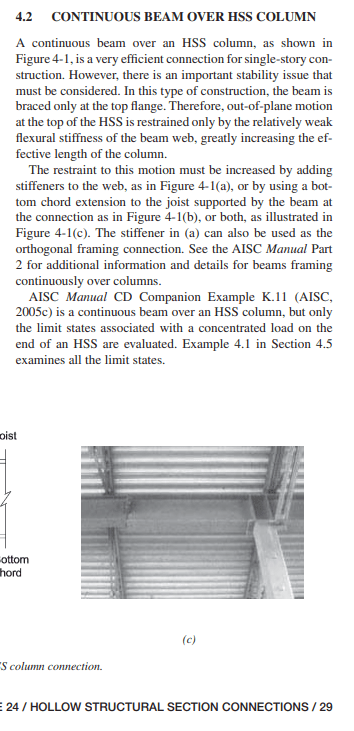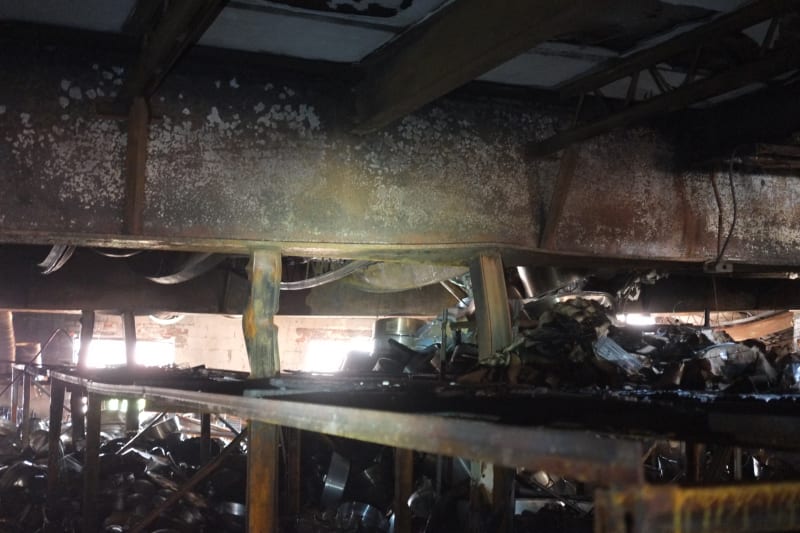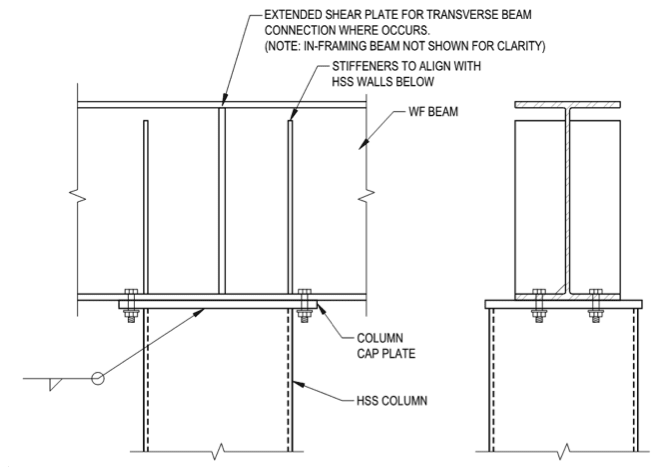Navigation
Install the app
How to install the app on iOS
Follow along with the video below to see how to install our site as a web app on your home screen.
Note: This feature may not be available in some browsers.
More options
Style variation
-
Congratulations TugboatEng on being selected by the Eng-Tips community for having the most helpful posts in the forums last week. Way to Go!
You are using an out of date browser. It may not display this or other websites correctly.
You should upgrade or use an alternative browser.
You should upgrade or use an alternative browser.
Cap plate for Pipe - How can release moments? 18
- Thread starter X4vier
- Start date
- Status
- Not open for further replies.
KootK said:In many practical situations, appropriate joint modelling has more to do with what's going with the members coming into the joint than with the restraint offered by the joint itself.
That's a good point.
I think that's a big part of why my firms have ignored the continuity. Often the column is something like HSS6x6 with I = 40 in4 and a W21x44 with Ix = 843 in4. If the column has a much higher MOI, then the column/beam combo is looking more like a moment frame, so again I'd start taking the continuity more seriously.
271828 said:If the column has a much higher MOI, then the column/beam combo is looking more like a moment frame, so again I'd start taking the continuity more seriously.
Agreed. Things are usually pretty clean cut in the interior of a building:
1) Spindly gravity columns that don't draw much moment or;
2) Beefy moment frame columns which obviously should be designed for moment.
The most common place where I feel that this occasionally warrants some non-"by inspection" level consideration is at perimeter "wind columns". There, one might design the columns to be deliberately stiff. And it's that stiffness that tends to draw the moments that are "incidental" but not insignificant.
Celt83 said:For what it’s worth AISC Design Guide 24 does call this a moment connection and advises the use of stiffeners or a joist brace connection directly to the column to restrain out of plane column buckling.
Save me a little time and point me to the section where that occurs?
Kootk said:The most common place where I feel that this occasionally warrants some non-"by inspection" level consideration is at perimeter "wind columns".
I've known engineers who designed these as simply supported columns for the axial load, and checked separately as a bending element for wind load. No interaction check.
Celt83 said:For what it’s worth AISC Design Guide 24 does call this a moment connection and advises the use of stiffeners or a joist brace connection directly to the column to restrain out of plane column buckling.
Celt83 said:Section 4.2 of Design Guide 24
The blurb below is the entirety of section 4.2 in my copy of DG24. Where in there do you see it calling this a moment connection?

Celt83 said:The title of chapter 4 is Moment Connections and the first worked example is a beam over hss connection with applied moment.
Right, but I would interpret those things to mean that such connections can be used to transfer moment when desired. I would not interpret them to mean that any particular part of the system must be designed for moment when that connection type is used.
It comes back to this:
KootK said:In many practical situations, appropriate joint modelling has more to do with what's going with the members coming into the joint than with the restraint offered by the joint itself.
Yes, this connection type will always transmit some moment between the incoming members. And, in that sense, it is always a "moment connection". But the presence of that joint restraint, on its own, does not mean that the joint will draw appreciable moment. A study of the surrounding system is necessary to determine whether or not that will occur.
Stated in dork-speak, joint restraint is necessary but not sufficient to draw appreciable moment to a joint.
SE2607 said:KootK - If the beam rotates at the top of the column, and the column is properly attached to the beam, isn't the top of the column going to rotate the same amount?
Yes. What conclusion do you draw from that observation?
Don' make me start speaking binary.
KootK said:Right, but I would interpret those things to mean that such connections can be used to transfer moment when desired. I would not interpret them to mean that any particular part of the system must be designed for moment when that connection type is used.
KootK said:joint restraint is necessary but not sufficient to draw appreciable moment to a joint.
It sounds like you're trying to have your cake and eat it too, KootK.
The joint restraint is necessary. Failure to properly restrain the joint could lead to some gnarly deformations below design load. As you say, the beam and column will rotate together. So if we fail to design the connection for the appropriate moment that is transferring through the joint, you can pop the bolts with the added tension from prying, we could yield the cap plate, or do any number of things that could hurt the connection's ability to remain stable even just as a "shear" connection.
So the joint itself must be designed for the moment. BUT...we can proportion the members of the system such that the moment that we have to design for is small.
A bit pedantic, perhaps, but I'm nothing if not that.
SE2607 said:If the top of the column rotates and is restraint in any way (pinned, fixed), then there is a moment in the column at the top.
Sure. The name of the game is not preventing moment from being generated in the top of the column. Rather, the goal is to keep it small enough that it does not warrant explicit attention. The logic chain would go something like this:
1) Make the beam stiff such that the joint rotates very little.
2) Make the column comparatively flexible such that the small joint rotation from [1] generates little moment.
3) Satisfy yourself that, owing to the small moments generated at the top of the column, combined stresses will not exceed the limits there.
4) Feel good that the governing failure mode remains whole column buckling which now benefits from some degree of rotational restraint at the top (K<1.0).
phamENG said:It sounds like you're trying to have your cake and eat it too, KootK.
How dare you attack me on the merits of my logic sir. Consider...
KootK said:Right, but I would interpret those things to mean that such connections can be used to transfer moment when desired. I would not interpret them to mean that any particular part of the system must be designed for moment when that connection type is used.
That statement parses out the meaning implied by the content of DG24 and says nothing about the actual behavior of the system.
KootK said:Joint restraint is necessary but not sufficient to draw appreciable moment to a joint.
That statement speaks to the actual behavior of the system and says nothing about the meaning implied by the content of DG24.
Apples and oranges.
Rescind! Or it's pistols at first light...

-
1
- #77
phamENG said:BUT...we can proportion the members of the system such that the moment that we have to design for is small.
Well, yeah. Is it really unclear to folks that this is about keeping the moments small rather than achieving absolute zero??
phanENG said:So the joint itself must be designed for the moment.
This statement and the one that follows it give the impression that you, yourself are routinely designing these types of connections for a small moment. Is that true? That's really what you are doing in your practice and is the message that you want to be putting out into the world with respect to your understanding of what the standard of care is here?
I'm mostly with Dave on this one. In 20+ years of practice I could count on one hand the number times that I've encountered interior "posts" that I felt warranted explicit attention with respect to incidental moment of the kind contemplated in this thread.
milkshakelake
Structural
SE2607 said:MSL - when you write "...it doesn't matter whether it's pinned or fixed, does it?..."(yeah, I forgot how to quote. Next time someone schools me on that, I'll write it down. At the time, it was so obvious, I said to myself "I'll remember that."), if the connection is pinned, then there is rotation in the beam at that point. Are you saying the top of the column does not rotate?
Sorry, missed this comment in the maelstrom of things. The quote button is like 4 steps to the right of "image", 6 steps to the left of "preview" when you're typing a reply. Anyway, that's not what I meant at all. I should be more specific:
For typical small cantilevered beams carrying a balcony or something with a cap-plated column underneath, the axial load in the column is very low. Much of the time, a tiny member like HSS4x4x1/4 will be stressed to 30% or less. It will be nearly impossible to overstress a member like that. Furthermore, if you undersize the cap plate, it'll just rotate a bit, but not that much. The bolts won't rupture from tension because even 1/2" bolts can take a lot more. So it doesn't matter if you assume it's pinned or fixed in terms of passing the design. Serviceability isn't a concern either. HSS4x4x1/4 (just as an example) can generally take 2-4 stories of load by itself and will barely be bothered by a single balcony. So yeah, it doesn't matter in this case. It's just a non-issue overall, any way you cut it, unless you're anywhere near the design ratio of that column.
For larger loads or transfer beams, or tall heights / slender columns, or weird conditions, there will definitely be an issue unless specific attention is paid to the column and its connection.
Just for fun, here's something I saw - a tiny column fixed to a massive W36 taking on some unintentional load transfer, twisting its big brother out of shape:

DaveAtkins
Structural
Wow, this is one of the best threads we have had in a while...
Another thing to consider is the likely failure mode for this type of structure. I have never heard of a column like this failing in axial plus bending due to ignoring the moment in the column (which, if I have not been clear, I agree is there). I have read articles where this type of connection fails at the beam column joint due to out of plane buckling of the bottom flange of the beam, which is in compression. This occurs when the bottom flange is not braced at the column location.
Early in my career, I saw beam over column framing used in an attempt to save money on weight of steel. You cantilever every other bay of framing to reduce midspan bending moment in the beams. I even think one of the AISC Design Guides deals with this type of system. But I have almost never done it, because it is: a) more work to do the calculations; b) involves more detailing, as I alluded to with the brace detail above; and c) I wonder if it is more difficult to build.
DaveAtkins
Another thing to consider is the likely failure mode for this type of structure. I have never heard of a column like this failing in axial plus bending due to ignoring the moment in the column (which, if I have not been clear, I agree is there). I have read articles where this type of connection fails at the beam column joint due to out of plane buckling of the bottom flange of the beam, which is in compression. This occurs when the bottom flange is not braced at the column location.
Early in my career, I saw beam over column framing used in an attempt to save money on weight of steel. You cantilever every other bay of framing to reduce midspan bending moment in the beams. I even think one of the AISC Design Guides deals with this type of system. But I have almost never done it, because it is: a) more work to do the calculations; b) involves more detailing, as I alluded to with the brace detail above; and c) I wonder if it is more difficult to build.
DaveAtkins
Was outright failure (collapse) ever even being debated?DaveAtkins said:Another thing to consider is the likely failure mode for this type of structure.
There have been at least two reported serviceability failures reported in this thread. Which you have conveniently ignored. Your initial claim of simply assuming away moment transfer is what started the debate. And from my perspective it remains absurd after dozens of posts as it did originally.
When somebody specifically wants to release moment transfer. Assuming it away is NOT a solution that any self-respecting engineer can justify.
- Status
- Not open for further replies.
Similar threads
- Question
- Replies
- 10
- Views
- 2K
- Replies
- 8
- Views
- 2K
- Question
- Replies
- 4
- Views
- 9K
- Replies
- 3
- Views
- 8K
- Replies
- 16
- Views
- 5K

